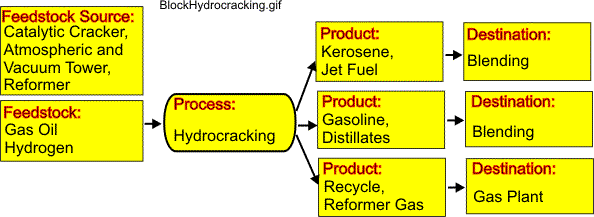 |
HYDROCRACKING
The figure provided here illustrates a block diagram for a hydrocracking process.
Hydrocracking is a two-stage process combining catalytic cracking and hydrogenation. The term “hydrogenation” indicates addition of hydrogen.
In this process heavier feedstocks are cracked in the presence of hydrogen to produce more desirable products. The process employs high pressure, high temperature, a catalyst, and hydrogen. Hydrocracking is used for feedstocks that are difficult to process by either catalytic cracking or reforming.
The hydrocracking process largely depends on the nature of the feedstock. Heavy aromatic feedstock is converted into lighter products under a wide range of very high pressures (1,000-2,000 psi) and fairly high temperatures (750-1,500 F or 400-800 deg C), in the presence of hydrogen and special catalysts.
Hydrocracking produces relatively large amounts of isobutane for alkylation feedstock. Hydrocracking also useful for pour-point control and smoke-point control, both of which are important in high-quality jet fuel.